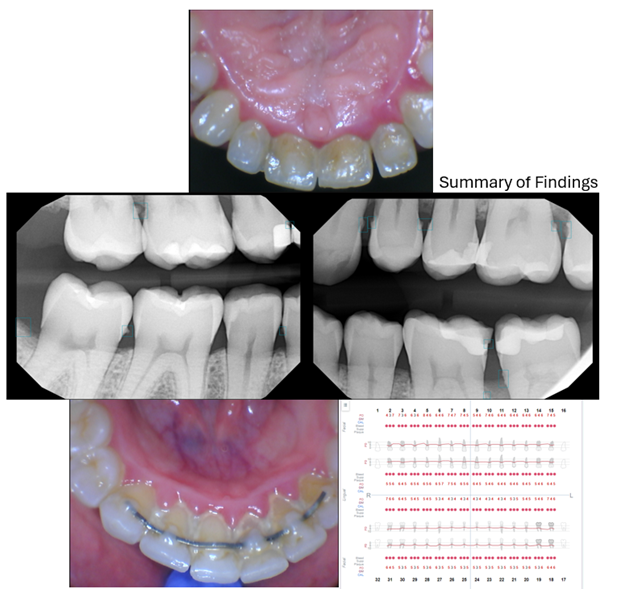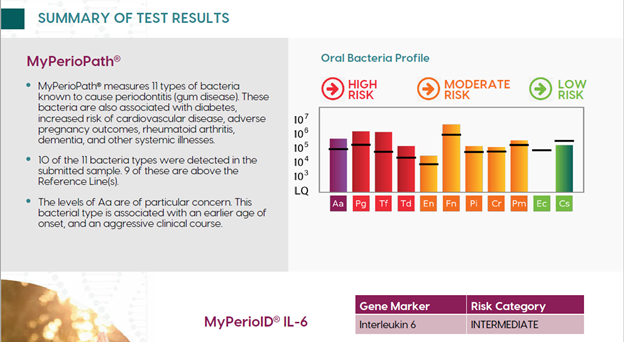In the evolving field of dental diagnostics, early detection is the key to effective management of periodontal disease. One of the latest advances in our practice is the utilization of OFC (Oral Fitness Check) by DentoGnostics, a groundbreaking tool that allows us to screen for active matrix metalloproteinase-8 (aMMP-8). The presence of aMMP-8 signals ongoing collagen breakdown, providing valuable insight into the health of the periodontal tissues. When detected, this makes our providers curious and prompts further investigation using Alert 2™ Salivary Diagnostics. This deeper evaluation pinpoints the presence of the 11 pathogenic bacteria responsible for the damage detected by the screening score, as well as genetic predisposition to inflammation.
At our practice, every new patient undergoes a comprehensive diagnostic protocol. This includes full-mouth X-rays (FMX), Cone Beam Computed Tomography (CBCT), an OFC screening sample, and probing of the periodontal pockets. This thorough approach allows us to gather essential objective data, serving as the foundation for a precise treatment plan. The probing of periodontal pockets helps measure the depth and assess the presence of inflammation or tissue damage. The OFC test specifically screens for collagen breakdown, giving us a clear picture of periodontal tissue health and identifying early signs of disease. These insights ensure our approach is rooted in evidence, improving the accuracy of our diagnosis and the effectiveness of subsequent treatments.
aMMP-8, a biomarker for active collagen degradation, plays a crucial role in understanding periodontal disease. It is an enzyme produced in response to inflammation within periodontal tissues. During periodontal breakdown, aMMP-8 levels increase, reflecting ongoing collagen destruction, which compromises the integrity of the gum and bone structure supporting the teeth. By measuring aMMP-8 levels through the OFC, we can detect early signs of periodontal disease even before substantial damage has occurred, allowing for timely intervention.
However, detecting collagen breakdown is only one part of the puzzle. For a more detailed analysis, the Alert 2 Salivary Diagnostics test is employed. Alert 2 not only identifies the presence of 11 pathogenic bacteria known to contribute to periodontal disease, but also assesses a genetic factor. This information reveals a patient’s genetic predisposition to respond aggressively to inflammation, offering a personalized understanding of their risk profile.
Treating Periodontal Disease: A Targeted Approach
Once we have identified the presence of pathogenic bacteria and active collagen breakdown, our approach to treatment involves a combination of scaling, antimicrobial irrigation, and laser decontamination. These procedures aim to manage bacteria that are resistant to traditional treatments:
1. Scaling targets biofilm and tartar deposits, which are often found deep below the gum line.
2. Irrigation introduces antimicrobial agents to reduce the bacterial load in periodontal pockets.
3. Decontamination ensures that even scaling-resistant bacteria are managed, reducing the risk of recurrence and promoting tissue healing.
This multi-faceted approach is designed to combat the persistent nature of periodontal pathogens, leading to more effective management of the disease.
A Case Study: Understanding the Power of OFC and Alert 2
Consider this patient:

This patient had an OFC score of 324, a reading that indicated significant collagen breakdown. To put this into context, an OFC score of 0-10 typically suggests average periodontal health, while scores ranging from 10-20 indicate some level of periodontal involvement, suggesting the onset of tissue damage. However, when the score reaches 30 or higher, it points to rapid collagen degradation and significant periodontal concerns.
With a score of 324, we may have to account that this number is an aggregate of other activated metalloproteinases like aMMP-1 (collagenase), aMMP-3 (stromelysin), and aMMP-12 (elastase), but this score is still a strong indicator of severe tissue breakdown and an active periodontal disease process. It highlights the need for further investigation and targeted intervention to address the ongoing damage.
In this patient’s case, the elevated OFC score, coupled with deep probing measurements and clinical indicators such as gum recession and inflammation, led us to order the Alert 2 test. The results confirmed a high concentration of all bacterial complexes, with a particular emphasis on the aggressive red complex. Additionally, the patient’s genetic profile revealed a heightened inflammatory response, which helped explain the rapid progression of their periodontal condition.
Acute vs. Chronic Inflammation: Understanding the Impact
It’s crucial to differentiate between acute and chronic inflammation in the context of periodontal disease. Acute inflammation is often a part of the body’s natural healing process—it’s a curative response to injury or infection. However, when inflammation becomes chronic, it can contribute to tissue destruction, particularly in the context of periodontal disease. This persistent state of inflammation allows bacteria to continue their destructive activity, leading to more severe tissue damage and loss of supporting structures.
The combination of OFC and Alert 2 Salivary Diagnostics allows for a comprehensive understanding of periodontal health. The OFC test acts as a sensitive screening tool, revealing the extent of collagen damage and prompting further investigation. In contrast, the Alert 2 test provides the high-resolution picture we need, pinpointing the exact bacterial culprits and the patient’s genetic predisposition to aggressive inflammatory responses. Together, these tools ensure that our practice stays ahead in the detection and management of periodontal disease, ultimately leading to better patient outcomes.
Through this approach, we are not just treating symptoms but targeting the underlying causes, ensuring long-term oral health for our patients while increasing the objective data points available throughout our longitudinal relationships with them, particularly in managing a refractory disease like periodontal disease.
- Revolutionizing Periodontal Disease Screening and Treatment with OFC and Alert 2™ Diagnostics - October 25, 2024
- Dr. Benavides: “Did We Overtreat: The Value of Proactive Intervention for the Periodontal Patient.” - August 23, 2024
- A Dental Detective Story – When a 102% Surge in Bacterial Load After Scaling Unveils a Horizontal Transmission Tale - April 5, 2024


